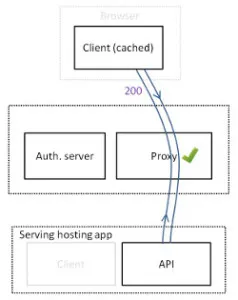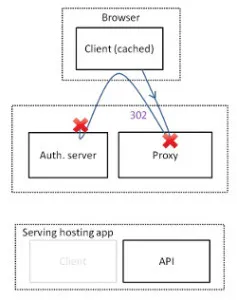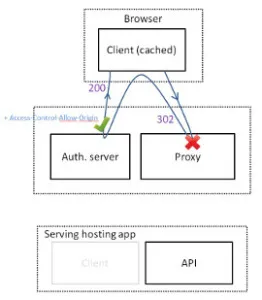Third-party proxy redirections in Angular app
Marc Perrin-Pelletier4 min read
If you’ve ever developed web applications for a large company, you must be familiar with having authentication done by a third-party proxy. And by third-party I mean handled by another team.
This is what our full stack javascript app architecture looks like:

The proxy is the door to your application, so it’s paramount that it behaves the way you expect it to. For instance when your session expires, you might expect a 401 from this proxy and build your app’s response around that. If you get a 302 instead, your app won’t work properly.
When the proxy’s behavior is controlled by another team, having to require their help takes time and introduces delays, so generally you try to make do with what you have! Following is a quick overview of how our team dealt with such a situation.
Diagnosis
In our case, we were having problems with API calls from our application:
XMLHttpRequest cannot load https://auth-server.com?sourceUrl=https%3A%2F%2Fmy-app.com%2Fapi%2Fexample. No 'Access-Control-Allow-Origin' header is present on the requested resource. Origin https://my-app.com/api/example is therefore not allowed.
is the chrome console error we kept having. After looking it up, this is what you get when trying to make a cross-domain ajax call.
By default, you are not allowed to request a resource from another domain via an ajax call. This prevents security issues such as cross-site scripting (XSS) attacks.
This is why none of our API calls actually went through.

Since our application is cached (via a cache manifest), when trying to use it while our authentication session has expired, we only fire ajax API calls to https://my-app.com/api/example. Unfortunately those calls are blocked and in the end, the user is never redirected to the login page.
How to allow cross-domain calls
Calling an asset via an ajax call is possible only if the domain which hosts that asset allows it. You can enable it by adding this header:
Access-Control-Allow-Origin: https://my-app.com
For the record, this header comes along with 3 others, which help you narrow down the rule to your specific need:
Access-Control-Allow-Methods: POST, GET, HEAD, OPTIONS
Access-Control-Allow-Headers: X-PINGOTHER
Access-Control-Max-Age: 1728000
Intercepting a 302 with Angular
Suppose we convince the authentication team to add the right header, we should then be able to intercept their 302 response whenever we fire a API call while unauthenticated. Right? This is how you intercept a specific http code with angular:
angular.module('http-auth-interceptor', ['http-auth-interceptor-buffer'])
.factory('httpMovedInterceptor', function($window, $location){
return {
response: function(rejection) {
var loginPage = 'https://auth-server.com/login'
if (rejection.status == 302 && rejection.config.url.split('?')[0] == loginPage) {
return $window.location.href = loginPage + '?sourceUrl=' + encodeURIComponent($location.absUrl())
}
}
};
})
.config(['$httpProvider', function($httpProvider) {
$httpProvider.interceptors.push('httpMovedInterceptor');
}])
...
First we create a factory to intercept 302 responses, then we register it with the $httpProvider.
Unfortunately this wouldn’t work! The 302 http code is dealt with at a browser level - as shown on below figure, meaning that your app cannot intercept the 302 in time and instead gets the 200 from the login page.

Solution
Ideal
Let’s stay pragmatic here! Probably the easiest and most efficient solution is to ask the authentication team to change the proxy’s response from 302 to 401. This way, you can easily detect when your API calls fail and ‘manually’ redirect your browser to your authentication login page.
However, the authentication team may not be able to comply with that need. For instance, if they have other teams excepting a 302 and cannot work on a case-by-case basis.
Workaround
If you have to stick with the 302s, what you’re left with is analyzing the API call responses and whenever you get a 200 code and page url that corresponds to your page login, you manually force your browser to load that page with:
$window.location.href = <you login page url>
Conclusion
Proxies which send you 302s on authentication can be a nightmare to deal with when developing API based applications. Do ask for 401s instead in response to any unauthenticated API calls. If that’s not achievable, you’ll have to expect your login page as a response to your ajax call and manually redirect to the login page in your browser.